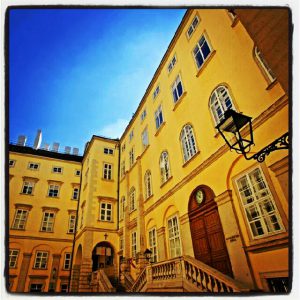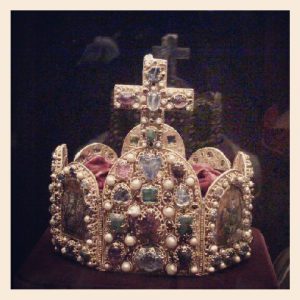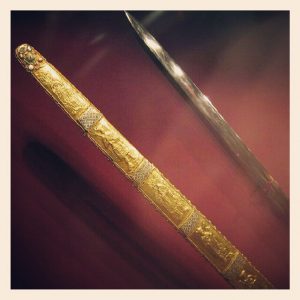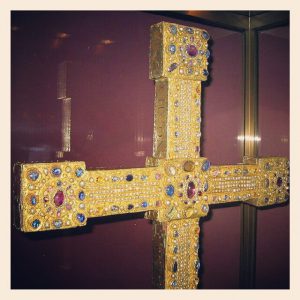Vienna´s Imperial Treasury at the Hofburg Palace
By Tracy A. Burns
Imperial crowns, coronation robes, scepters, orbs, and miters as well as breathtaking, gem-studded reliquaries are just a few of the many objects in the Hofburg Palace’s Imperial Treasury, one of the must-sees of any trip to Vienna. The regalia and other riches are divided into secular and ecclesiastical sections into 21 rooms. The exhibition spans more than 1,000 years of European royal history.
The history of the collection
 The collection was compiled in Nuremberg in 1556 by Jacopo Strada, the antiquarian of Emperor Ferdinand I. Then, around 1800, Empress Maria Theresa had the collection moved to its present location. During World War II the Nazis took the jewels back to Nuremberg, but at the end of the war, the relics were returned to the Hofburg.
The collection was compiled in Nuremberg in 1556 by Jacopo Strada, the antiquarian of Emperor Ferdinand I. Then, around 1800, Empress Maria Theresa had the collection moved to its present location. During World War II the Nazis took the jewels back to Nuremberg, but at the end of the war, the relics were returned to the Hofburg.
Room 11: The crown
 The highlight of the exposition is found in room 11, where the lavish crown donned by Holy Roman Emperor enthralls. This crown was worn during the sovereigns’ coronation ceremonies, without which it was not possible to gain the title of emperor. Imagine Emperor Charles IV or Emperor Rudolf II donning this very crown at the extravagant ceremony. Hailing from the second half of the 10th century, the crown was most likely forged for the coronation of Emperor Otto in 962. The rich ornamentation of the crown carries rich, symbolic meaning. For example, the eight gold plates decorated with precious stones and pearls stand for the eight gates of Jerusalem. On each of the two largest plates, there are 12 gems, representing the 12 apostles and the 12 tribes of Israel. A cross made of jewels dating back to the 11th century also decorates the holy relic. A sapphire shaped like a heart mesmerizes, too.
The highlight of the exposition is found in room 11, where the lavish crown donned by Holy Roman Emperor enthralls. This crown was worn during the sovereigns’ coronation ceremonies, without which it was not possible to gain the title of emperor. Imagine Emperor Charles IV or Emperor Rudolf II donning this very crown at the extravagant ceremony. Hailing from the second half of the 10th century, the crown was most likely forged for the coronation of Emperor Otto in 962. The rich ornamentation of the crown carries rich, symbolic meaning. For example, the eight gold plates decorated with precious stones and pearls stand for the eight gates of Jerusalem. On each of the two largest plates, there are 12 gems, representing the 12 apostles and the 12 tribes of Israel. A cross made of jewels dating back to the 11th century also decorates the holy relic. A sapphire shaped like a heart mesmerizes, too.
The Holy Lance
 The Holy Lance in the same room goes back to the Carolingian times of the eighth century. Roman Emperor Constantine the Great, who ruled from 306 to 337, triumphed in battles with this astounding weapon. Perhaps he is best known as the first Roman Emperor to convert to Christianity. That is not the lance’s only claim to fame. Since the 13th century, it has been believed that this is the lance that Longinus used to pierce the side of Christ on the Cross. Legends about the Holy Lance abound. For instance, in Trevor Ravenscroft’s 1973 book The Spear of Destiny, Adolf Hitler instigated World War II in order to obtain this holy relic. Whoever loses the lance dies, according to the legend. Hitler lost the Longinus lance to US General George S. Patton, who possessed it at the end of the war. The legend was fulfilled because Hitler committed suicide.
The Holy Lance in the same room goes back to the Carolingian times of the eighth century. Roman Emperor Constantine the Great, who ruled from 306 to 337, triumphed in battles with this astounding weapon. Perhaps he is best known as the first Roman Emperor to convert to Christianity. That is not the lance’s only claim to fame. Since the 13th century, it has been believed that this is the lance that Longinus used to pierce the side of Christ on the Cross. Legends about the Holy Lance abound. For instance, in Trevor Ravenscroft’s 1973 book The Spear of Destiny, Adolf Hitler instigated World War II in order to obtain this holy relic. Whoever loses the lance dies, according to the legend. Hitler lost the Longinus lance to US General George S. Patton, who possessed it at the end of the war. The legend was fulfilled because Hitler committed suicide.
The Imperial Cross
 The Imperial Cross, dating from 1024 to 1025, boasts gold plates over wood. Engravings of the 12 apostles, the symbols of the Evangelists, and the Lamb of God adorn this treasure that is also decorated with inscriptions. The front bewitches with precious stones and pearls. Emperors swore oaths of office on the Imperial Book of Gospels which has gold lettering and four illuminated renderings of evangelists that date back to the eighth century. The Late Gothic silver-gilt cover was made circa 1500 and shows God the Father on a throne. The swordbearer who marched in front of the Emperor used to carry the Imperial Sword, which boasts 14 gold plates with pictures of sovereigns. It dates back to the era of Emperor Charlemagne (742-814).
The Imperial Cross, dating from 1024 to 1025, boasts gold plates over wood. Engravings of the 12 apostles, the symbols of the Evangelists, and the Lamb of God adorn this treasure that is also decorated with inscriptions. The front bewitches with precious stones and pearls. Emperors swore oaths of office on the Imperial Book of Gospels which has gold lettering and four illuminated renderings of evangelists that date back to the eighth century. The Late Gothic silver-gilt cover was made circa 1500 and shows God the Father on a throne. The swordbearer who marched in front of the Emperor used to carry the Imperial Sword, which boasts 14 gold plates with pictures of sovereigns. It dates back to the era of Emperor Charlemagne (742-814).
Another captivating crown
But the crown of the Holy Roman Emperor is not the only dazzling crown on display. The private crown of Rudolf II, made in Prague between 1598 and 1602, was used for state events while the imperial crown was only used for the coronation ceremonies. A circlet is decorated with eight lily formations, symbolizing the imperial office. Diamonds and rubies make this jewel dazzle. A striking blue sapphire tops it off. The High Priest’s miter is just as impressive. A Rudolf II, triumphant in war, is portrayed on four gold-embossed bas-reliefs. A scepter and orb also enthrall.
The best baby present
When Napoleon’s son was born, the ruler appointed his male offspring the King of Rome. The city of Paris gave the newborn what perhaps is the nicest baby gift in the world – a throne shaped as a silver-gilt cradle. Symbolism abounds on this treasure as it is dotted with allegorical figures. The goddess of Fame carries a laurel wreath above a globe. An eagle steers itself toward the star of Napoleon. Many golden bees, Napoleon’s personal symbol, also adorn the luxurious treasure.
A few gems
Gems abound in this collection, but perhaps the most impressive is the 2,860-carat Columbian emerald – the world’s largest – carved into an ointment vessel that was made in Prague in 1641. A 416-carat ruby set in enamel and shaped like an imperial double eagle is on display, too.
Artifacts from Emperor Ferdinand I
The regalia worn by Emperor Ferdinand I when he was crowned King of Lombardy-Venetia in 1835 is just one of many stunning imperial garments to see. Two of this emperor’s most precious artifacts are unique. The agate bowl carved from a single piece of agate, most likely created in Constantinople during the fourth century AD, was once considered to be the Holy Grail. Another impressive piece is a huge narwhal tusk measuring 243 centimeters. It has been considered to be the horn of a unicorn, which is the symbol of the Virgin Mary and the Incarnation of Christ.
Other notable items in the collection
Imperial robes do indeed make up a significant part of the collection, including the robes of the King of Bohemia. The King of Bohemia’s silver gilded orb and scepter dating from the 14th century also are on exhibit. The Bohemian ruler’s gloves are exquisite, made of gold lace. Do not miss the imperial robes made for King Roger II in 1133-1134. The mantle is embroidered with gold thread on carmine silk that shows off rows of pearls. The christening gown of Emperor Franz Joseph I and his siblings stands out as well. A tiered amber altar made in Germany from 1640 to 1645 is sure to impress. Reliquaries contain a tooth of John the Baptist and a piece of wood from Christ’s manger, for example. Robes and relics from the order of chivalry known as the Order of the Golden Fleece adorn this collection, too. The Order was created by Philip the Good of Burgundy in 1430 to celebrate his marriage to Princess Infanta Isabella of Portugal and still exists as a prestigious European order. The neckchain includes two rows of interchangeable coats of arms so that the current members’ insignia can appear.
Some ecclesiastical treasures
The ecclesiastical section includes religious items such as a reliquary containing a nail that pierced Christ’s right hand at the crucifixion. Emeralds and sapphires are just two of the gems that dazzle on this piece. Pieces of the cross from the crucifixion have been placed in a large monstrance decorated with diamonds and garnets.




